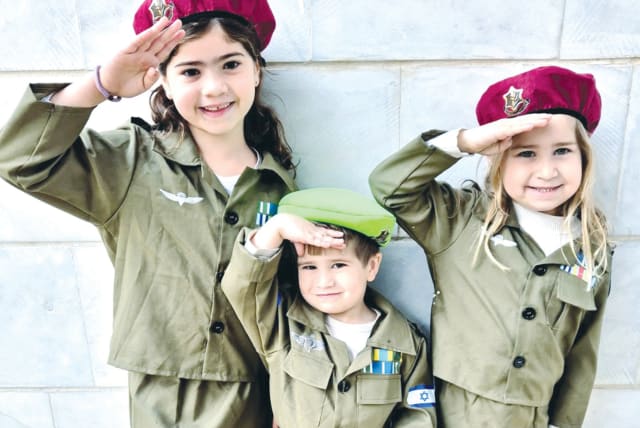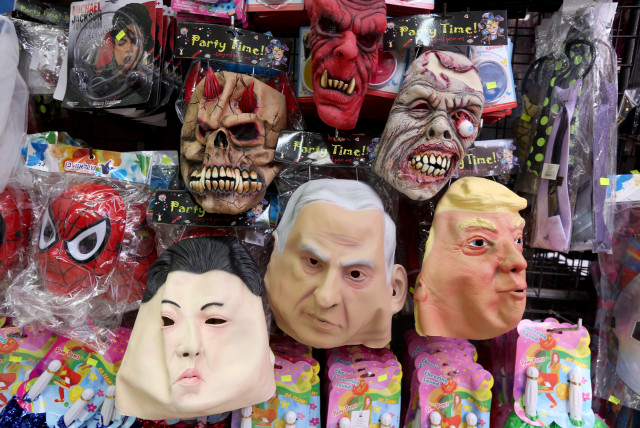The debate over Purim costumes prompts reflection about war - opinion

The debate surrounding children’s costumes extends beyond Purim celebrations to broader societal issues, such as the role of the soldier and the exemption of yeshiva students from IDF service.
Purim has been and gone. Mountains of sugar have been eaten, we have banged at the mention of the name of the wicked Haman and we have given our gifts to one another and charity to the poor – just like every year. But this year there was a different feel to the celebrations of the joyous festival of Purim because of the entrenched war in Gaza and the ongoing threat facing us in the North. This year, a contentious debate arose, challenging the very essence of celebration against the backdrop of conflict.
Many questioned the very idea of revelry, parties, disguises, and merriment while our hostages remain in captivity deprived of their freedom, and who knows, maybe their very lives too. Additionally, some considered it insensitive at best and downright crass at worst for us to be so outwardly celebratory in the face of so many bereaved families of the victims of the Simhat Torah massacre, and the fallen soldiers.
On the other hand, some expressed the idea that “They can’t celebrate, so we must-on their behalf.” Others saw the full participation in Purim fun as a signal to the enemy that we are, by no means, neither defeated nor defeatist in our attitude. We will prevail.
Similarly, the debate extends to other national celebrations, such as Independence Day, where fireworks traditionally light up the skies in commemoration of Israel’s statehood. However, in light of the ongoing conflict, questions arise about the appropriateness of such displays, with some arguing that the use of fireworks may evoke distressing memories for those living in areas affected by violence.
The arguments on both sides are strong.
This debate also centered around the portrayal of soldiers in children’s costumes.
However, to fully grasp the significance of this debate, it is essential to trace its roots back to the origins of Purim and the evolution of children’s costumes.
Purim, a holiday commemorating the deliverance of the Jewish people from a genocidal plot in ancient Persia, is intricately woven with themes of disguise and revelation. The story of Esther, central to the holiday, is replete with instances where things are not as they appear. Esther herself conceals her true identity as a Jew, while the antagonist, Haman, hides his nefarious intentions behind a facade of loyalty. God’s ever-present hand is hidden from view, and His Name is not mentioned even once in the entire Book of Esther.
IN LIGHT of this narrative, the tradition of children disguising themselves during Purim takes on a deeper significance. Historically, children would dress as the heroes of the Purim story, with girls often portraying Queen Esther and boys emulating Mordechai the Jew. These costumes served not only as a form of festive attire but also as a means of engaging with the themes of concealment and revelation central to the holiday.
However, over time, the tradition has evolved, reflecting broader cultural shifts and influences. In contemporary Israel, it has become fashionable for children to dress as modern-day superheroes, such as Superman or Wonder Woman, during Purim festivities. This shift in costume choices is emblematic of a society increasingly influenced by global popular culture.
Against this backdrop, the prevalence of children dressed in soldier uniforms during this year’s Purim celebrations can be understood. Soldiers, revered as modern-day heroes in Israeli society, have become synonymous with the archetype of the superhero. Their bravery and selflessness in defending the nation are celebrated and emulated, particularly by children who look up to them as role models.
However, the juxtaposition of soldiers as heroes and the realities of war raises complex ethical questions. While honoring the sacrifices of soldiers is paramount, the glorification of warfare, particularly in the context of children’s celebrations, warrants careful consideration.
Further, the use of firearms as props in children’s costumes raises valid concerns about the desensitization to violence and its potential psychological effects, particularly on those who have experienced the traumas of war firsthand. The combination of innocence with symbols of warfare serves as a stark reminder of the realities faced by many in the region, challenging the notion of celebration in the midst of conflict.
Moreover, the debate surrounding children’s costumes extends beyond the realm of Purim celebrations to broader societal issues, such as the role of the soldier and the exemption of yeshiva students from military service. There was a costume depicting a child in half a soldier’s uniform and half yeshiva student garb which went viral on social media. This provoked harsh and sometimes unpleasant reactions.
The debate over Purim costumes is a microcosm of our national debate
SOME SAW this as a declaration of unity, indicating that no matter which part of society one is from, we are all playing our part in the victory over the enemy. Others saw the costume as a thinly veiled political statement equating the learning of Torah with sacrifice on the battlefield, a concept that has been anathema to many people for years, and especially so now.
This serves as a microcosm of the tensions felt here in Israel right now and highlights the delicate balance between religious devotion and national duty. These are perennial and contentious issues which won’t go away on their own and require dealing with head on. The status quo cannot continue, on that both sides agree.
Fury around this issue has been reignited by the inflammatory words of Sephardi Chief Rabbi Rav Yitzhak Yosef who asserted that, if forced to join the army, haredim would collectively move abroad.
Rosh Yeshiva of Orot Shaul Rav Tamir Granot, whose son Amitai (HY”D) fell in battle a few months ago, in response, describes how his wife was distraught at Yosef’s words because it negated the ultimate sacrifice of her son who did both – learned Torah and served in the army via the Hesder program.
The danger here, is not just the issue itself, which is incredibly difficult but the way in which it is debated.
As the discussions unfold, it is imperative to engage in constructive dialogue that fosters understanding and respect for diverse perspectives. While differing opinions are inevitable, they should be approached with sensitivity and empathy, avoiding the pitfalls of divisiveness and derogatory speech.
Respect for the sacrifices made by soldiers must be balanced with a critical examination of the implications of glorifying violence, particularly in the context of children’s celebrations, and the wider issues of National Service in its differing guises.
In conclusion, the debate surrounding Purim costumes, soldiers, and societal values in Israel reflects the complexities inherent in navigating life amid conflict. It prompts a deeper reflection on the role of the soldier, the impact of war on communities, and the need for nuanced discussions that prioritize unity and mutual respect. As Israel grapples with these issues, it is through open dialogue and a commitment to empathy that the path toward reconciliation and understanding can be forged.
Without it, we will destroy ourselves long before our enemy destroys us.
The writer is a rabbi and physician living in Ramat Poleg, Netanya, and is a cofounder of Techelet-Inspiring Judaism.
Jerusalem Post Store
`; document.getElementById("linkPremium").innerHTML = cont; var divWithLink = document.getElementById("premium-link"); if (divWithLink !== null && divWithLink !== 'undefined') { divWithLink.style.border = "solid 1px #cb0f3e"; divWithLink.style.textAlign = "center"; divWithLink.style.marginBottom = "15px"; divWithLink.style.marginTop = "15px"; divWithLink.style.width = "100%"; divWithLink.style.backgroundColor = "#122952"; divWithLink.style.color = "#ffffff"; divWithLink.style.lineHeight = "1.5"; } } (function (v, i) { });

